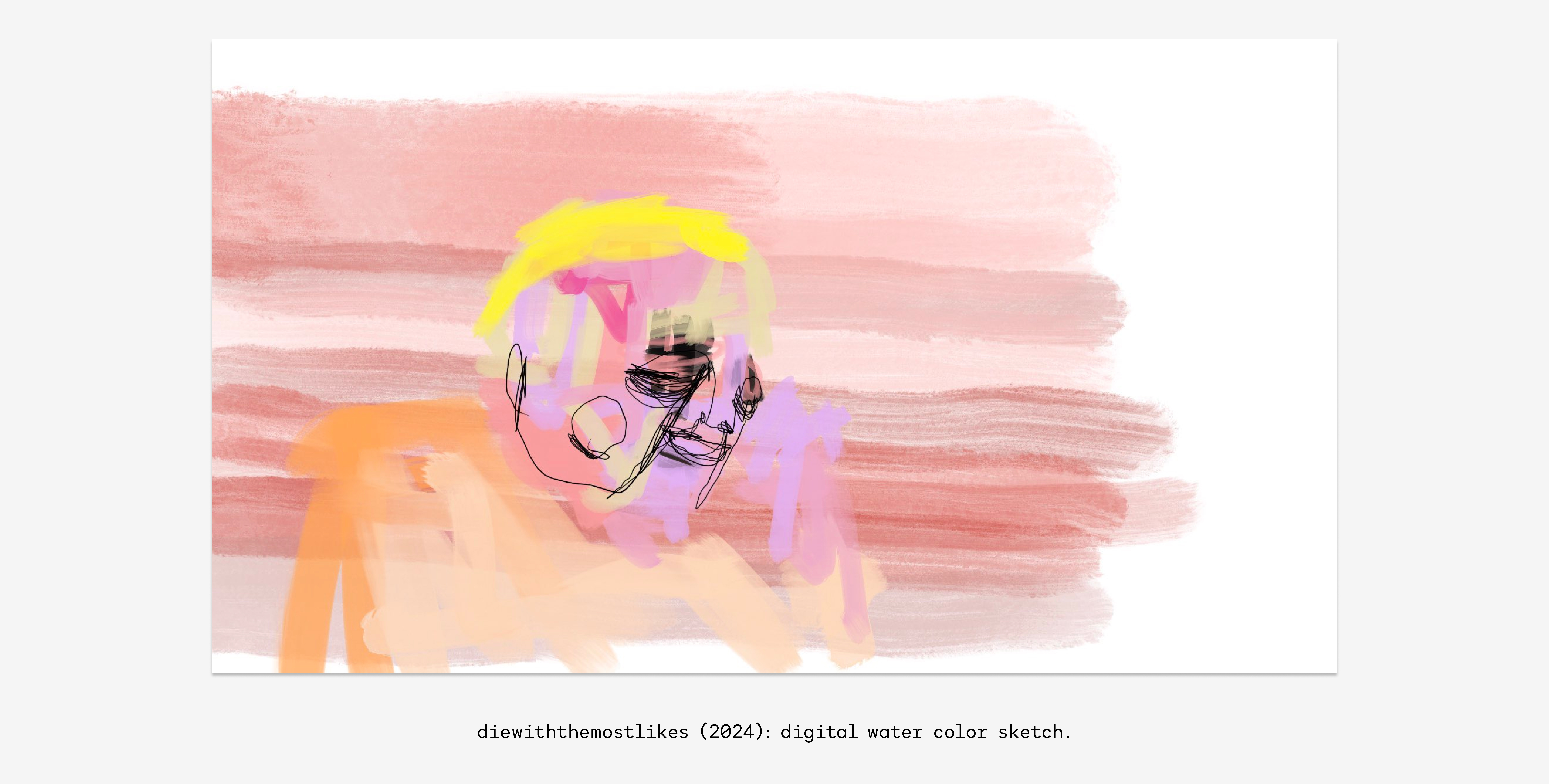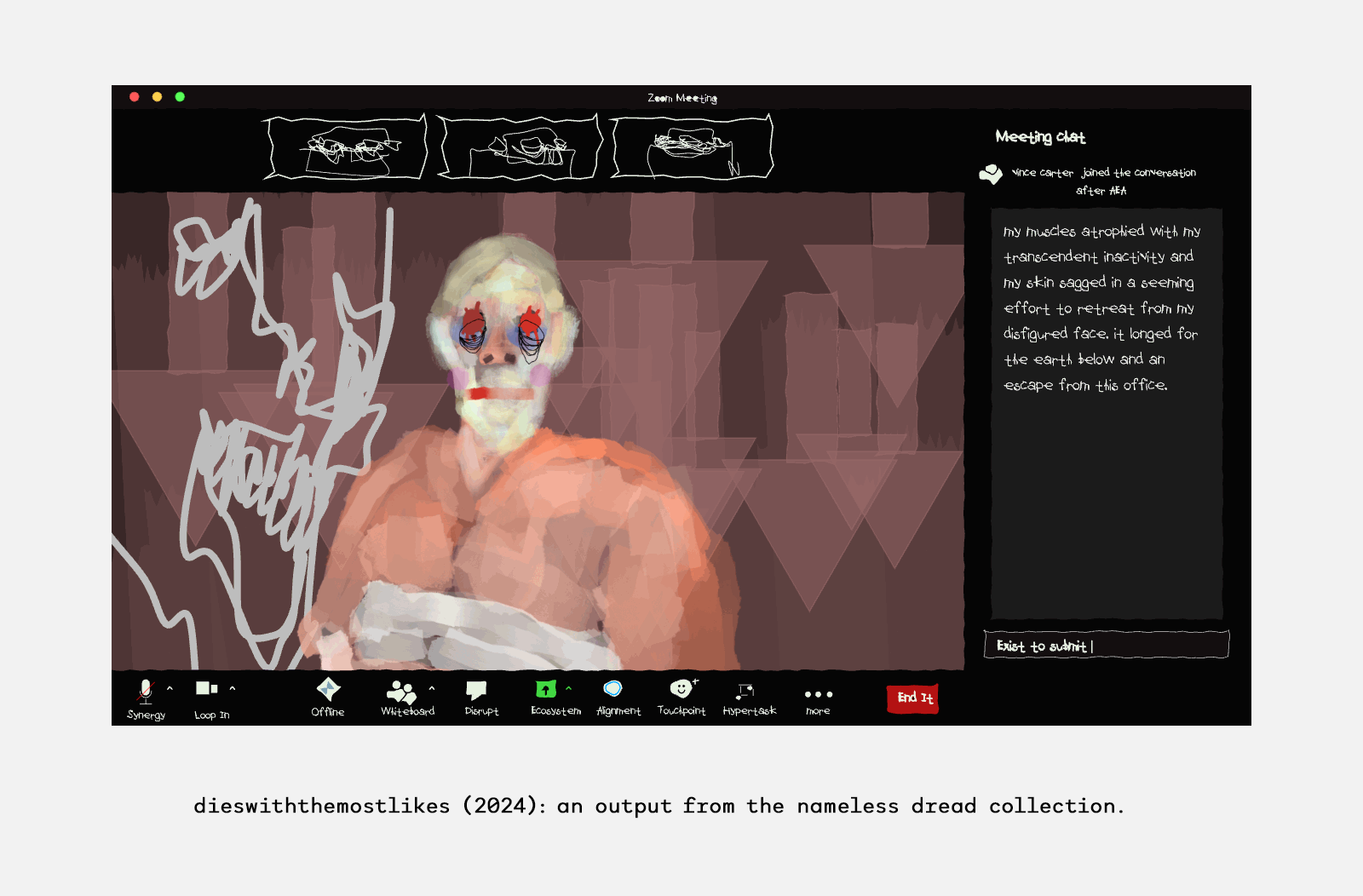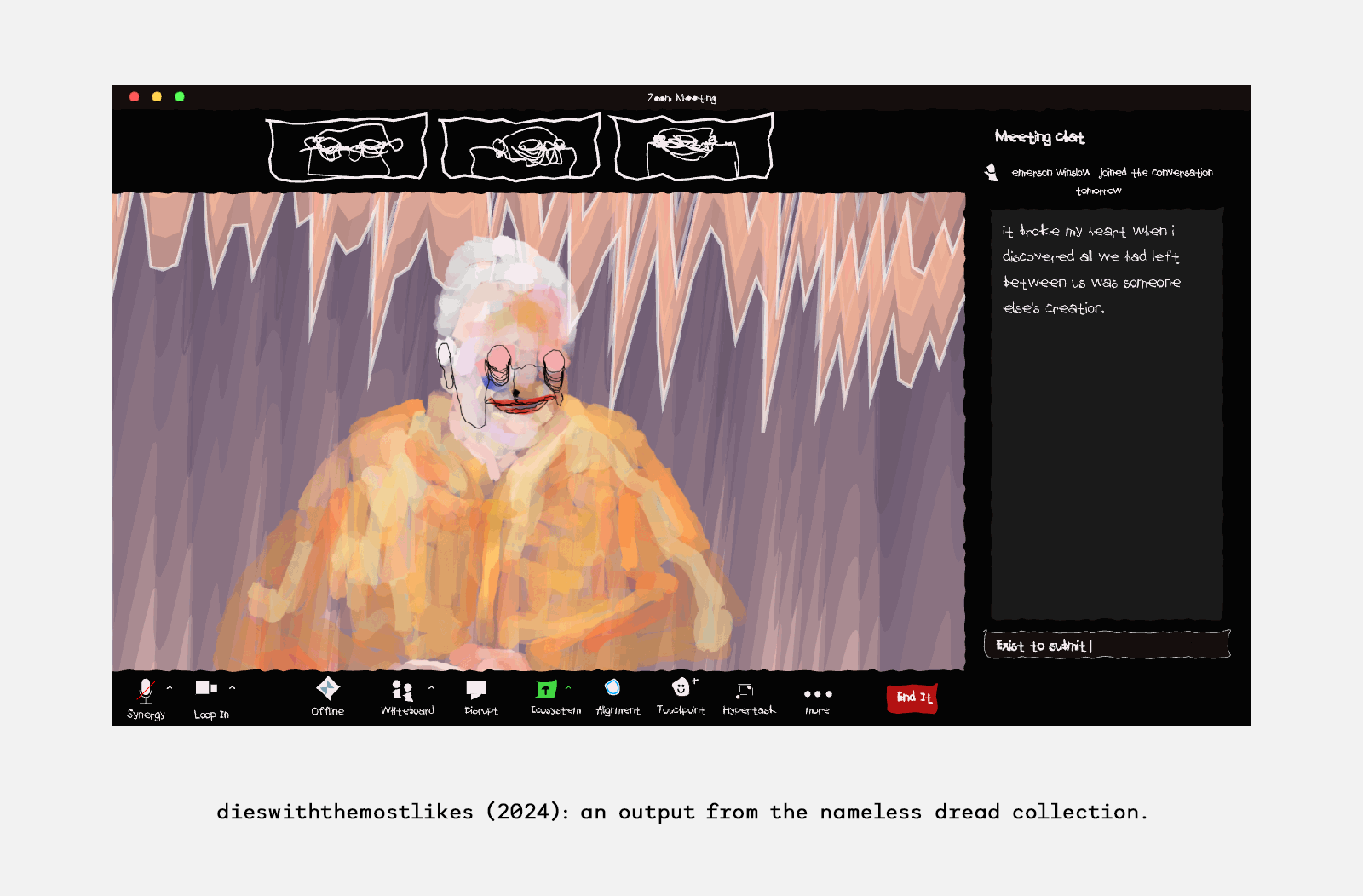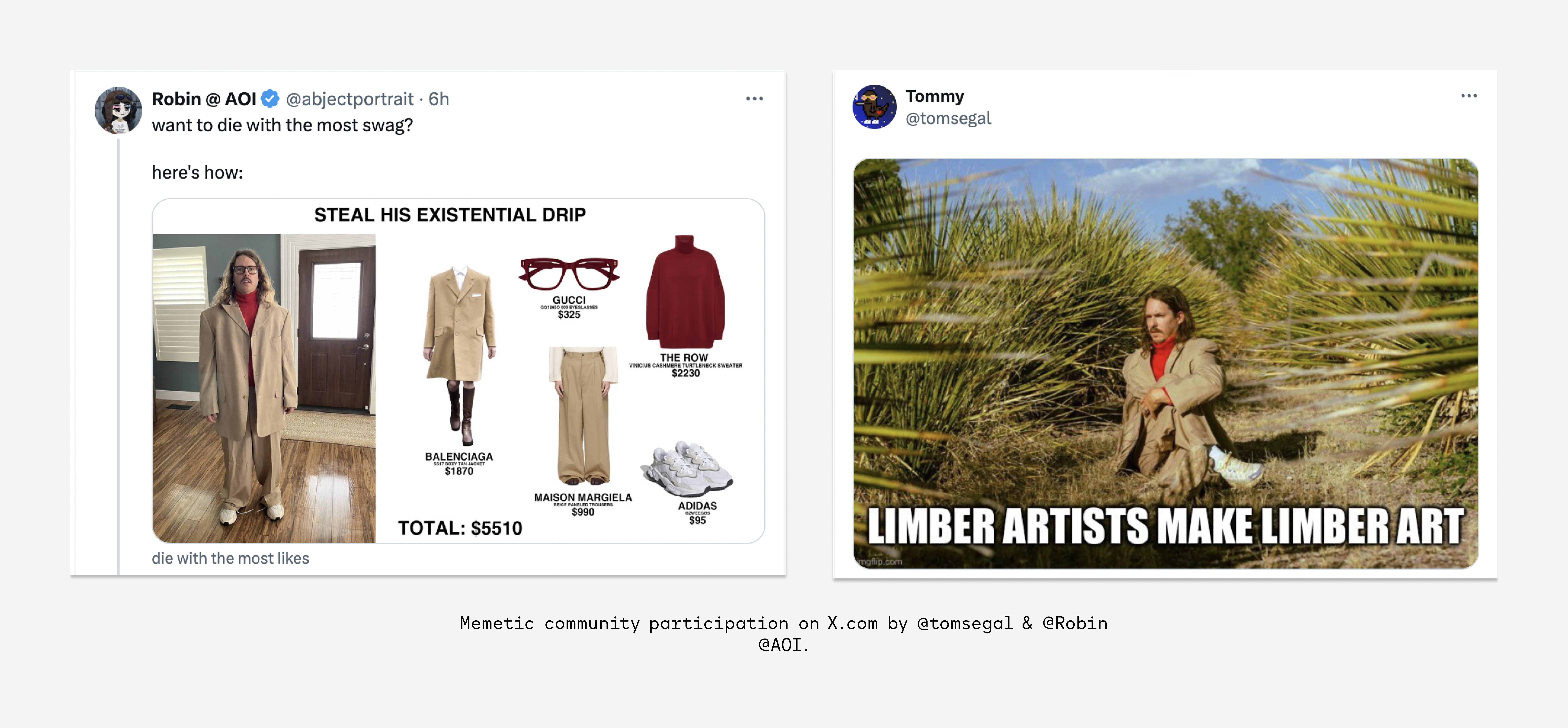The defining cultural experience of the post-Covid work environment is seeing one’s own reflection on a computer screen. In these now familiar moments, we remain in solitude (together), glued collectively to our screens, faces boxed across a sterile interface.
_%20Untitled%20Film%20Still%20%232.jpg)
In nameless dread artist diewiththemostlikes (“DWTML”) explores this primal scene of 21st century internet culture. While his generative collection’s outputs are clearly unique portraits, the concept of still life, or nature morte (literally, “dead nature”), might best describe the work.
Put simply, the collection is an autopsy of our contemporary life, drained of vitality and meaning.
For each procedurally generated output, the artist hand-drew a portrait “employee” in a digital watercolor style (relying on analog drafts). The use of soft brushstrokes and harmonious pastel colors, a departure from the artist’s usual, more comic-like style, contrasts sharply with the figures’ formlessness, while the fine, harsh black lines that define the facial features imbue the portraits with their grotesque characteristics.
These portraits are framed by a drawn Zoom interface, set against animated backgrounds with generative elements, in varying color palettes. Formally, the backgrounds range with traits like squiggle-like compositions and swirls of flies, and colors span from black to dark red to light pastels, to the “meat” tones favored by the artist in other works. The outlines of unsightly, distorted faces flicker on some of these backgrounds, gazing at the person at the center.
Together, the application of hand-drawn and procedurally generated features sustains the tension between surprisingly harmonious elements and the dread of the subject matter, mirrored in the faces of the portrayed figures.

The 669 hand-drawn employee portraits embody the nameless dread evoked by the title—a kind of digital spleen, which the collection seems to diagnose as the prevailing mood in a terminally online work culture.
Spleen, a concept coined by French poet Charles Baudelaire, depicts a profound sense of dissatisfaction, melancholy, and nihilistic boredom Baudelaire saw emerging as the defining mood of modernity. It’s no coincidence that the English translation uses the same concept that DWTML chose for the title of his collection.
“Hereafter, mortal clay, you are no more than a rock encircled by a nameless dread”.1
The existential exploration of DWTML’s work stands in this lineage of artists deciphering the mood of contemporary life.

The mood of the work is unmistakably marked by mortality.
Death is both metaphorically and literally at the center of this collection. Everything in DWTML’s internet world bears the mark of transience: the characters are either dead, decaying, or so morbidly afflicted that death appears to assert its victory over life. And, death is used as a representation of the cycle of screen-focused work and consumption characteristic of contemporary life.
The morbidity symbolizes a life that is not quite living, or, perhaps, a life that is more about dying than living. Such a metaphor could also be applied to DWTML’s obsession with meat - what was alive, is now not only dead, but food for the next “mortal clay”.
And on and on it goes.
Generative randomness expands DWTML’s digital drawing style into a new format in nameless dread and, conversely, opens up the medium of long-form generative art to new creative trajectories beyond abstract compositions; it exposes the form to dissonance.

Although DWTML previously incorporated randomness using JavaScript to combine pictorial elements in previous collections, nameless dread is his first work to leverage a generative algorithm in the technical sense to tap into emergent compositions.
In what one may read as an artistic reenactment of the monotony of digital suffering that the project thematizes, each of the 669 outputs is a hand-drawn 1-of-1 work by the artist, which is nested within a generative composition. As such, the work maintains the artist’s signature aesthetic while breaking new ground, yielding a long-form collection that is at once strangely beautiful, characteristically repulsive and a combination of code-based automation and manual, even monotone artistic labor.

Similar to the themes explored in his visual works, DWTML’s remarkably poetic writings also dwell obsessively on the inevitable decay of all things. Any search for meaning, the artist’s texts declare, is condemned as futile and vain in light of the unstoppable digital and physical entropy.
In nameless dread, DWTML’s haunting prose is autonomously generated in the Zoom chat box – an endless stream of words lamenting an insufferable condition created with a custom font based on DWTML’s handwriting.
A typical output might read: “I got used to death. Sometimes I even looked forward to it. But still I didn’t fancy creating digital waste.”
Strangely, though, the intensely sinister subject matter of these works never feels suffocating or depressive. On the contrary, there is a deep sense of humor the viewer encounters at the center of these works.
Lethal Aesthetics
The humor in DWTML’s work might stem from the audience recognizing themselves in these subjects staring back at them.
Every viewer senses obscurely that the work holds up a mirror — exaggerated but accurate. nameless dread not only thematizes the Zoom interface as a mirror of the self, but also serves as a mirror itself.
What do we see in this Zoom mirror?
The obsessive reference to death and affliction is often reminiscent of a classic evocation of memento mori, reminding the audience of their mortality and the futility of earthly pursuits. The memento mori theme traditionally allows for both religious readings, anticipating the afterlife, and worldly ones: seizing the moment, as life is singular and fragile.
On the face of it, DWTML’s work engages with these questions, imbuing his momento mori with shocking humor.
.jpg)
There is yet another layer to DWTML’s work, connected to how it addresses the obscene and the horrific.
nameless dread, like his other works, plays with horror without shocking the viewer with outright disgust. Although the artist confronts his audience with the limits of representation — depicting decomposing bodies, and in other works, excrement, madness, and nudity—his “soft” drawing style mitigates the shock these objects might usually trigger.
_%20Piss%20Christ.jpg)
On an abstract level, DWTML’s works confront the viewer with elements that culture has repressed and excluded, yet he does so in a manner that remains approachable and viewable.
Art historians of the 20th century adopted a technical term from psychoanalysis to describe works that engage with these themes: “desublimation.”2 While art is typically regarded as an elevation, a means of lifting something into a realm “higher,” more beautiful, and more “pure” than ordinary life, works engaging with desublimation invert this notion.
They debase what they portray and confront the viewer with elements typically excluded from everyday life and the realm of culture: excrements, vomit, corpses, et cetera.
While shocking to some, the bulk of DWTML’s “terminally online” audience came of age in the time of adult cartoons employing desublimation in commercial content. Television shows like The Simpsons, Beevis and Butthead, and King of the Hill (shows that also share aesthetic parallels to DWTML’s oeuvre) similarly challenge what should or shouldn’t be consumed in civilized society by pushing the boundaries on “potty humor”. If you were a kid in the 90’s and allowed to watch these shows, DWTML renders a nostalgia for animated impropriety.
_%20Short%20Haired%20Cheese-4ce1e4.jpg)
In the “high” art context, consider artists and writers like Georges Bataille, Piero Manzoni, Andres Serrano, Mike Kelly, Robert Gober, among many others, who also explored an (an)aesthetic of desublimation.
One of the most infamous of these works is Manzoni’s Merda d’artista, an edition of 90 signed and numbered 30-gram cans of excrement— “freshly preserved, produced and tinned,” as stated on the label.
These works were priced per gram using the current price of gold, equating the artist’s excrement with gold (the works would wildly outperform gold in the following decades). However, Manzoni’s work is not merely a commentary on value (a theme that often appears in DWTML’s work as well). As John Miller noted, it also demonstrates “that which literally comes from the artist’s interior turns out not to be revelatory, but repellent.”3
_%20Merda%20d%E2%80%99Artista%20(Artist%20Shit).jpg)
The same could be said of DWTML’s work. In interviews and social media, the artist often describes his creative output in scatological terms: as an uncontrollable outpouring of what is inside of himself. And what emerges as his work is undeniably repulsive and not a revelation of something higher. It is, rather, an unfiltered snapshot of our contemporary condition.
Similarly, nameless dread holds up a mirror, presenting the viewer with an image that conflicts with the natural order of the world. It brings out a repressed dread and meaninglessness in our lives – and as such, it thematically stands in stark contrast to the compulsory positivity that often defines the crypto art scene.
In this way, nameless dread is a profound engagement with everyday life on the internet, while simultaneously disrupting it.
During the inaugural “30 Days in Marfa” residency by glitch Gallery, DWTML provided his viewership with an intimate look at his creative process, transforming the entire residency into a self-ironized performance. The audience’s reactions to the material shared on X.com demonstrates the mimetic potential of nameless dread, as they responded in the work’s idiom and style, portraying themselves as doomed to follow the fate of earthly things.

Despite its ironic undercurrent, DWTML’s work ultimately poses a profound question to the audience: how do we confront the revelation that our lives are defined by a nameless dread? Is resignation and indifference towards inevitable entropy the appropriate response?
DWTML’s work refrains from providing a concrete answer. However, the artist’s mimetic humor hints at something beyond resignation and apathy. Could humor and violent laughter be our last resort when faced with the truth about our contemporary condition?
At last, DWTML’s nameless dread seems to find redemption in the joy of creation, violent laughter, and – in the end – good meat.
-
Charles Baudelaire, Les Fleurs du Mal, Spleen (J’ai plus de souvenirs), in the translation of Richard Howard. In the French original, Baudealire speaks of “vague épouvante.” ↩
-
See, for instance, Rosalind Krauss and Yve-Alain Bois, Formless: A User’s Guide (New York: Zone Book, 1997). ↩
-
John Miller, “Excremental value,” in https://www.tate.org.uk/tate-etc/issue-10-summer-2007/excremental-value ↩